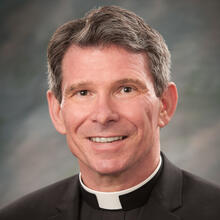A Homily for the Commemoration of All the Faithful Departed
Readings: Wisdom 3:1-9 Romans 6:3-9 John 6:37-40
Back in the 1920s, physicists struggled with a subatomic problem. They could lock in a particle’s position, or they could describe its momentum. Either could be measured with rather impressive accuracy. They just could not do both at the same time.
In the physics that Isaac Newton gave us, which still works so well on the level of daily experience, everything can be located in time and space. Indeed, time can be defined as movement through space. But in 1927, a very young German scientist named Werner Heisenberg addressed the subatomic problem with what would become known as his “Uncertainty Principle.”
It is not just that physicists cannot identify a subatomic particle’s position and momentum at the same time. Astonishingly, a particle does not have a position or momentum in any meaningful way until the scientist decides to measure one or the other. Put another way, way down there, things disappear and reappear apparently without moving through space or time.
If this foray into quantum physics is unsettling for you, calling purgation, or the process of a soul’s spiritual cleansing, a “spiritual uncertainty principle” will be as well. But here is where the two branches of knowledge run parallel. They both demand that we accept the uncertainty of moving beyond time and space when we leave the confines of our everyday world.
Here’s how that plays out on the question of purgation after death. St. Thomas Aquinas followed the Greek philosopher Aristotle in speaking of everything within our world as being in process. Everything around us is always becoming something else. So are we. As these two philosophers put it, in every moment of its existence, everything is moving from potentiality into actuality. Everything is becoming something it has not yet become. The one exception to this rule is God, who is defined as pure actuality. Nothing is coming to be in God. Everything already is.
What does this have to do with the early Christian conviction that a purgation follows death? (Requests for prayers can be found on tombs in the Roman catacombs.) In our lives, we constantly move from the potential to the actual. Put another way, we asymptotically approach God. Now, in our lives before death, we do this in time and space. We can be observed growing up, growing wise, growing in grace. (Of course, the opposite might also be observed!)
At death, most of us will still fall short of who God called us to be, which is someone perfectly ready to receive the fullness, the actuality that is God. This means that somehow, though not in some time or some place, God must move us from what is potential to what is actual. And, just as our prayers aid each other in that process on this side of the grave, they do so as well on the other.
This is where, just as on the quantum level of physics, our ability to picture a process gives out. We understand what it means to become who we were meant to be in time and space. We cannot begin to imagine how we do that outside of time and space.
Hence purgation as the spiritual uncertainty principle. We know that God in mercy brings us to completion, makes us capable of receiving divine life. What was unrealized potential in our lives becomes, by God’s power and God’s mercy, fully actualized. But whoever decided to speak of “purgatory” rather than “purgation” did the faith no service. “Purgatory” suggests both a time and a space, neither of which is accurate.
Not long ago, I was with my former scoutmaster as he died. Harold said something that was both astonishingly accurate and humble. He said: “I’m going to Jesus. I hope that I’ve lived my life in a way that makes him ready to receive me.”
There’s the spiritual uncertainty principle of purgation. In his humility, Harold realized that what he had become in life was only a fraction of who God is, who God wants us to become. Harold did not lower God to his level. Yet Harold could confess that he had indeed striven to be ready for God.
After death, how God in mercy and with the aid of our prayers moves Harold from the potential to the actual is quite uncertain. But that Harold had really readied himself for this final mercy on the part of God, of that there can be no meaningful doubt.








